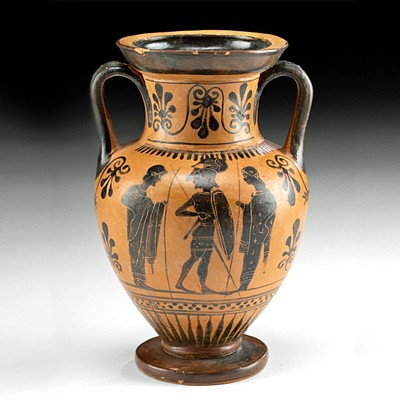Exhibited Roman Glass Cinerarium w/ Lid - Intact!
About Seller
686 S Taylor Ave, Ste 106
Louisville, CO 80027
United States
Selling antiquities, ancient and ethnographic art online since 1993, Artemis Gallery specializes in Classical Antiquities (Egyptian, Greek, Roman, Near Eastern), Asian, Pre-Columbian, African / Tribal / Oceanographic art. Our extensive inventory includes pottery, stone, metal, wood, glass and textil...Read more
Two ways to bid:
- Leave a max absentee bid and the platform will bid on your behalf up to your maximum bid during the live auction.
- Bid live during the auction and your bids will be submitted real-time to the auctioneer.
Bid Increments
| Price | Bid Increment |
|---|---|
| $0 | $25 |
| $300 | $50 |
| $1,000 | $100 |
| $2,000 | $250 |
| $5,000 | $500 |
| $10,000 | $1,000 |
| $20,000 | $2,500 |
| $50,000 | $5,000 |
| $100,000 | $10,000 |
| $200,000 | $20,000 |
About Auction
Mar 9, 2023
Artemis Fine Arts info@artemisfinearts.com
- Lot Description
Roman, Imperial Period, ca. mid-1st to 2nd century CE. An astonishing funerary vessel used for holding cremated human remains called a cinerarium (or cinerary urn) that is hand-shaped from soft blue glass that, once transparent, has developed weathering film to create a translucent presentation. The substantial form exhibits a broad piriform body, a slightly concave base, a gently carinated midsection which tapers up towards the squat neck, and a thick, everted rim with the excess folded underneath rather than being removed. Accompanying the body is a discoid lid formed from similar glass with a slender body, a sharply curved rim, and a tubular central handle with a pinched tab on top. Both components are enveloped with delicate layers of rainbow-hued iridescence which create a distinguished presentation. Size (body): 8.15" W x 9.3" H (20.7 cm x 23.6 cm); 12" H (30.5 cm) with lid; (lid): 4.8" W x 3.1" H (12.2 cm x 7.9 cm)<br><br>Most scholars agree, Roman glass was of the highest quality - both aesthetically and technically - among the ancients. While glass making had been practiced for centuries, glass blowing was invented in the Roman-controlled Holy Land in the 1st century BCE. This innovative technology revolutionized the artform. We can appreciate such a wide variety of forms and shapes, because the medium of glass has unique physical properties that make for so many more possibilities which would eventually replace a wide variety of pottery and metal wares in the ancient world. Roman glassmakers reached incredible artistic heights with both free-blown vessels and mold blown forms and decorations and were traded far beyond the Roman Empire. Roman glass vessels have been found in Scandinavia, India, and in Han Dynasty tombs in China. <br><br>Exhibited in “Ancient Glass: Selections from the Richard Brockway Collection” at the Hallie Ford Museum of Art at Willamette University, Salem from March 10 to May 19, 2007 and “Glass of the Ancient World” at the Vero Beach Museum of Art, Florida from October 11 to December 28, 2008.<br><br>Published in “Ancient Glass: Selections from the Richard Brockway Collection.” Hallie Ford Museum of Art at Willamette University, Salem, 2007; “Glass of the Ancient World.” Vero Beach Museum of Art, Florida; and “Antiques & Art Around Florida,” Fall 2009 – Winter 2010. “Collecting Ancient Glass” by Richard Brockway with Lynette Macleod, pp. 26-27, 44-45, 47.<br><br>Cf. The Metropolitan Museum of Art, accession numbers 81.10.4a,b and 91.1.1231.<br><br>A similar example - without a lid and of smaller size - hammered for GBP 11,875 ($14,280.28) at Christie's, London, South Kensington "Antiquities" auction (sale 2390, October 6, 2011, lot 210).<br><br>Provenance: private Vero Beach, Florida, USA collection, acquired before 2003 <br><br>#177442
Condition
Body and lid have earthen deposits and light calcifications, minor pitting in scattered areas, weathering film across most surfaces, and scattered abrasions, otherwise intact and choice. Small area of adhesive residue from previous inventory label beneath base and atop lid. Beautiful rainbow iridescence, outstanding size, and incredibly well-preserved!
- Shipping Info
-
All shipping is handled in-house for your convenience. Your invoice from Artemis Gallery will include shipping calculation instructions. If in doubt, please inquire BEFORE bidding for estimated shipping costs for individual items.
-
- Buyer's Premium



 EUR
EUR CAD
CAD AUD
AUD GBP
GBP MXN
MXN HKD
HKD CNY
CNY MYR
MYR SEK
SEK SGD
SGD CHF
CHF THB
THB















